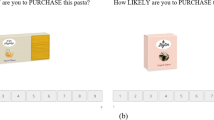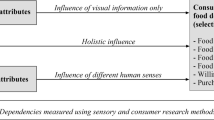Abstract
We compared a direct way to measure the relative importance of packaging and other extrinsic cues like brand name, origin, and price with the relative importance of these variables in an indirect discrete choice experiment. We used best–worst scaling (BWS) with visual and verbal presentation of the attribute descriptions as a way to directly ask consumers about wine packaging relevance. Both direct methods gave low packaging importance scores contrary to anecdotal industry evidence and beliefs. BWS results indicated all visual extrinsic cues were less important than verbal cues, with small variance among respondents, suggesting strong agreement about non-importance. We compared those results with a multi-media-based discrete choice experiment (DCE) that varied label and packaging attributes to produce shelf-like choice scenarios. The DCE results revealed much higher impacts due to packaging-related attributes, as well as significant preference heterogeneity. Our results suggest considerable caution in using direct importance measures with visual packaging attributes.




Similar content being viewed by others
Notes
\( \frac{1}{S}\left( {\sum\nolimits_{s = 1}^S {\text{Best}} - \sum\nolimits_{s = 1}^S {\text{Worst}} } \right) \), where is S is number of respondents; also see Mueller and Rungie (2009).
Seeing the photograph or not was the dependent variable and individual best–worst scores for each attribute were the independent variables in the logistic regression (for details, see Mueller et al. 2007).
Random parameter choice models not accounting for differences in respondents' choice consistency (error variance) confound utility heterogeneity with the unobserved distribution of error variances (Islam et al. 2007; Louviere and Eagle 2006). We accounted for differences in error variance by modeling two scale classes with high (higher λ) and low (smaller λ) choice consistency (Swait and Louviere 1993).
References
Auger, P., Devinney, T., & Louviere, J. (2007). Using best–worst scaling methodology to investigate consumer ethical beliefs across countries. Journal of Business Ethics, 70, 299–326.
Bacon, L., Lenk, P., Seryakova, K., & Veccia, E. (2008). Comparing apples to oranges. Marketing Research Magazine, Spring, 29–34.
Barber, N., Almanza, B. A., & Donovan, J. (2006). Motivational factors of gender, income and age on selecting a bottle of wine. International Journal of Wine Business Research, 18(3), 218–232.
Bargh, J. A. (2002). Losing consciousness: automatic influences on consumer judgment, behavior, and motivation. Journal of Consumer Research, 29, 280–285.
Boudreaux, C. A., & Palmer, S. (2007). A charming little Cabernet: effects of wine label design on purchase intent and brand personality. International Journal of Wine Business Research, 19(3), 170–186.
Breitmeyer, B. G., Ogmen, H., & Chen, J. (2004). Unconscious priming by color and form: different processes and levels. Consciousness and Cognition, 13, 138–157.
Cardello, A. V., & Sawyer, F. M. (1992). Effects of disconfirmed consumer expectations on food acceptability. Journal of Sensory Studies, 7(4), 253–277.
Chartrand, T. L. (2005). The role of conscious awareness in consumer behavior. Journal of Consumer Psychology, 15, 203–210.
Dahan, E., & Srinivasan, V. (2000). The predictive power of internet-based product concept testing using visual depiction and animation. Journal of Product Innovation Management, 17(2), 99–109.
Deliza, R., & MacFie, H. J. H. (1996). The generation of sensory expectation by external cues and its effect on sensory perception and hedonic ratings: a review. Journal of Sensory Studies, 11(2), 103–128.
Deliza, R., MacFie, H., & Hedderley, D. (2003). Use of computer-generated images and conjoint analysis to investigate sensory expectations. Journal of Sensory Studies, 18(6), 465–486.
Dijksterhuis, A., & Smith, P. K. (2005). What do we do unconsciously? And how? Journal of Consumer Psychology, 15, 225–229.
Dijksterhuis, A., Smith, P. K., Van Baaren, R. B., & Wigboldus, D. H. J. (2005). The unconscious consumer: effects of environment on consumer behavior. Journal of Consumer Psychology, 15, 193–202.
Fazio, R. H. (2001). On the automatic activation of associated evaluations: an overview. Cognition & Emotion, 15(2), 115–141.
Fazio, R. H., Blasovich, J., & Driscoll, D. M. (1992). On the functional value of attitudes: the influence of accessible attitudes upon the ease and quality of decision making. Personality and Social Psychology Bulletin, 18, 388–401.
Finn, A., & Louviere, J. J. (1992). Determining the appropriate response to evidence of public concern: the case of food safety. Journal of Public Policy & Marketing, 11(2), 12–25.
Fitzsimons, G. J., Hutchinson, J. W., Williams, P., Alba, J. W., Chartrand, T. L., Huber, J., et al. (2002). Non-conscious influences on consumer choice. Marketing Letters, 13, 269–279.
Flynn, T. N., Louviere, J. J., Peters, T. J., & Coast, J. (2007). Best–worst scaling: what it can do for health care research and how to do it. Journal of Health Economics, 26, 171–189.
Gianluca, S., Donato, R., & Cavicchi, A. (2006). Consumer expectations, liking and willingness to pay for specialty foods: do sensory characteristics tell the whole story? Food Quality and Preference, 17(1–2), 53–62.
Goodman, S. (2009). An international comparison of retail consumer wine choice. International Journal of Wine Business Research, 21(1), 41–49.
Imram, N. (1999). The role of visual cues in consumer perception and acceptance of a food product. Nutrition and Food Science, 99(5), 224–228.
Islam, T., Louviere, J. J., & Burke, P. F. (2007). Modeling the effects of including/excluding attributes in choice experiments on systematic and random components. International Journal of Research in Marketing, 24(4), 289–300.
Jaeger, S. R. (2006). Non-sensory factors in sensory science research. Food Quality and Preference, 17(1–2), 132–144.
Lang, A. (2000). The limited capacity model of mediated message processing. Journal of Communication, 50(1), 46–70.
Lange, C., Martin, C., Chabanet, C., Combris, P., & Issanchou, S. (2002). Impact of the information provided to consumers on their willingness to pay for Champagne: comparison with hedonic scores. Food Quality and Preference, 13(7–8), 597–608.
Lee, J. A., Soutar, G., & Louviere, J. (2008). The best–worst scaling approach: an alternative to Schwartz's values survey. Journal of Personality Assessment, 90(4), 335–347.
Louviere, J., & Eagle, T. (2006). Confound it! That pesky little scale constant messes up our convenient assumptions, 2006 Sawtooth Software Conference Proceedings, Sequim (WA).
Louviere, J., & Islam, T. (2008). A comparison of importance weights/measures derived from choice-based conjoint, constant sum scales and best-worst scaling. Journal of Business Research, 61, 903–911.
Louviere, J. J., & Woodworth, G. (1983). Design and analysis of simulated consumer choice or allocation experiments: an approach based on aggregated data. Journal of Marketing Research, 20(4), 350–367.
Louviere, J. J., Hensher, D. A., & Swait, J. D. (2000). Stated choice methods: Analysis and application. Cambridge: Cambridge University Press.
MacInnis, D. J., & Price, L. L. (1987). The role of imagery in information processing: review and extensions. The Journal of Consumer Research, 13(4), 473–491.
Magidson, J., & Vermunt, J. K. (2002). Latent class models for clustering: a comparison with K-means. Canadian Journal of Marketing Research, 20, 37–44.
Marley, A. A. J., & Louviere, J. J. (2005). Some probabilistic models of best, worst, and best–worst choices. Journal of Mathematical Psychology, 49(6), 464–480.
Mueller, S., & Rungie, C. (2009). Is there more information in best–worst choice data? Using attitude heterogeneity structure to identify consumer segments. International Journal of Wine Business Research, 21(1), 24–40.
Mueller, S., Lockshin, L., Louviere, J., & Hackman, D. (2007). Do respondents use extra information provided in online Best–Worst choice experiments? Proceedings of the Xth Australian and New Zealand Marketing Academy (ANZMAC) Conference, Dunedin, New Zealand, 3–5 December 2007, 3486–3493.
Nisbett, R. E., & Wilson, T. D. (1977). Telling more than we can know—verbal reports on mental processes. Psychological Review, 84, 231–259.
Orth, U. R., & Malkewitz, K. (2008). Holistic packaging design and consumer brand impression. Journal of Marketing, 72, 64–81.
Paivio, A., & Csapo, K. (1973). Picture superiority in free recall: imagery or dual coding? Cognitive Psychology, 5(2), 176–206.
Powell, M., & Ansic, D. (1997). Gender differences in risk behaviour in financial decision-making: an experimental analysis. Journal of Economic Psychology, 18(6), 605–628.
Ro, T., Singhal, N. S., Breitmeyer, B. G., & Garcia, J. O. (2009). Unconscious processing of color and form in metacontrast masking. Attention, Perception & Psychophysics, 71, 95–103.
Rocchi, B., & Stefani, G. (2005). Consumers' perception of wine packaging: a case study. International Journal of Wine Marketing, 18(1), 33–44.
Roskos-Ewoldsen, D. R., & Fazio, R. H. (1992). In the orienting value of attitudes. Attitude accessibility as a determinant of an object's attraction of visual attention. Journal of Personality and Social Psychology, 63, 198–211.
Silayoi, P., & Speece, M. (2007). The importance of packaging attributes: a conjoint analysis approach. European Journal of Marketing, 41(11/12), 1495–1517.
Srinivasan, V., Lovejoy, W. S., & Beach, D. (1997). Integrated product design for marketability and manufacturing. Journal of Marketing Research, 34(1), 154–163.
Street, D. J., & Burgess, L. (2007). The construction of optimal stated choice experiments: Theory and methods. New York: Wiley-Interscience.
Swait, J., & Louviere, J. (1993). The role of the scale parameter in the estimation and comparison of multinominal logit models. Journal of Marketing Research, 30, 305–314.
Szolnoki, G. (2007). Measurement of the influence of extrinsic product design on purchase intent for white wine. PhD thesis, Justus-Liebig-University Giessen, Geisenheimer Berichte Bd. 61, Geisenheim.
Van Ittersum, K., Pennings, J. M. E., Wansink, B., & van Trijp, H. C. M. (2007). The validity of attribute–importance measurement: a review. Journal of Business Research, 60(11), 1177–1190.
Venkatesh, V., Morris, M. G., & Ackerman, P. (2000). A longitudinal field investigation of gender differences in individual technology adaptation decision-making processes. Organizational Behavior and Human Decision Processes, 83(1), 33–60.
Vermunt, J. K., & Magidson, J. (2008). LG-Syntax™ user's guide: manual for Latent GOLD® 4.5 syntax module. Belmont Massachusetts: Statistical Innovations Inc.
Vriens, M., Loosschilder, G. H., Rosbergen, E., & Wittink, D. R. (1998). Verbal versus realistic pictorial representations in conjoint analysis with design attributes. Journal of Product Innovation Management, 15(5), 455–467.
Author information
Authors and Affiliations
Corresponding author
Rights and permissions
About this article
Cite this article
Mueller, S., Lockshin, L. & Louviere, J.J. What you see may not be what you get: Asking consumers what matters may not reflect what they choose. Mark Lett 21, 335–350 (2010). https://doi.org/10.1007/s11002-009-9098-x
Received:
Accepted:
Published:
Issue Date:
DOI: https://doi.org/10.1007/s11002-009-9098-x




